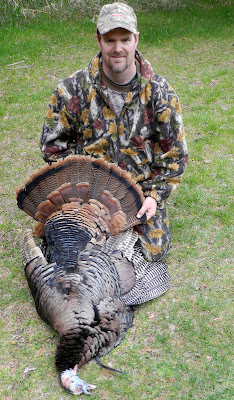Two of the floating aids in the Detroit Harbor channel, buoys number 4 and 5, are being replaced by permanent structures. The new aids to navigation will be solid cylinders of steel, cement and stone, anchored by nine H-piles into bedrock, and topped with a steel pole upon which will be a light, solar panel and battery.
This contract, estimated to be in the half-million dollar range, was bid to the Rock company of Pontiac, Michigan. Door County marine contractor Roen Salvage, of Sturgeon Bay, is the major sub-contractor. Other subcontractors include the drilling company that bored the holes for the pilings, and suppliers of the buoy cylinders and light towers.
Two of Roen's work barges are shown in the photo here shortly after they began the project. Pipes of 14" diameter were set into the bottom a the buoy locations, then used as guides as they were drilled out, down three feet into bedrock. Nine H-piles per navigation aid were then inserted into the drilled holes inside each pipe, and then epoxied into place using a special grout mixed with sand. The pipes were removed once the epoxy was set
These permanent aids to navigation had been proposed for several years by the U. S. Coast Guard, but funding wasn't in hand until this fiscal year. The new aids should eliminate drift from station (something that did occur with the older, floating buoys, especially as ice forced against them). Batteries, solar panels and bulbs can be accessed easily for servicing by Coast Guard Aids to Navigation team members by small boat. Formerly, a shallow-draft Coast Guard vessel would cross the lake from its home port in Muskegon to lift the floating aids with an A-frame, and its crew would inspect each chain and sinker. The buoys would then be repainted, with chain replaced, if needed, before being reset on station.
The tops of the new 12-ft. diameter cylinders will stand approximately 7 1/2 feet above water level, and have a nearly 20-ft. mast on top of that. These will make a strong target on radar scopes, and they will also be more easily seen during nighttime or low visibility by vessel operators. (One of two cylinders is shown in the photo below as it is lifted from the semi to the Roen work barge, alongside Northport Pier.)
Roen Salvage is the largest and oldest marine contractor in the area. This company typically bids on marine construction projects such as dredging, break wall and dock construction around the Great Lakes. From Detroit Harbor, this rig will prepare to sail to the upper St. Mary's River, where several similar, but larger, navigational aids will be constructed. When that job is completed, the construction equipment will be towed to Duluth harbor at the western end of Lake Superior for another project that will include dredging of 200,000 cu. yds. and driving pilings for commercial shipping.
Actual work on the Detroit Harbor aids to navigation began Monday, May 24, after the equipment had been mobilized to the island. Work is expected to be completed - barring delays in supply of the light towers - by Friday, June 8th. The steel cylinders that shape the base of the aids and the light pole assemblies are pre-fab items subbed to another company in the Fox Valley. Delays in receiving those items could possibly prolong the project's completion.
Shown below is Don Sarter, Construction Supervisor and a 39-year Roen employee, who also operates the tug Stephan M. Asher that tows and positions the work barges.
Not yet known, but to be determined soon, is the fate of the dredging application by the Town of Washington for the Detroit Harbor channel. This application, submitted earlier this calendar year, is believed to have cleared the citizen's committee that reviews such applications. If so, it now awaits further review for approval by the WISDOT secretary, and finally, approval and signature must be given by Wisconsin's governor. If approval is given and funding is released, this would mean a huge improvement for Washington Island, a major dredging operation that will widen and deepen a navigation channel last touched in 1937!
This project could possibly be undertaken yet this calendar year. However, approval and funding dollars through a Wisconsin Harbor Assistance Program Grant to the Town of Washington must first receive approval in order for any dollars to be allocated. There were four or five other Wisconsin commercial port applicants, each with worthy projects competing for those same dollars.
- Dick Purinton

















